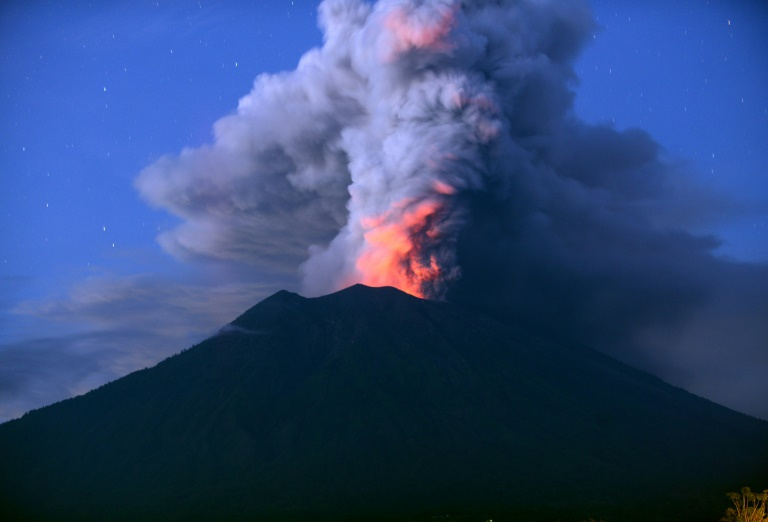
Mount Agung in Bali — which could blow at any time — ejected one billion tonnes of volcanic debris in 1963, a fraction of the size of historic “super-eruptions”. Image: Sonny Tumbelaka / AFP
The last volcanic “super-eruption” big enough to erase civilization as we know it happened 25,000 years ago — but these types of blasts occur every 17,000 years on average, according to a revised calculation out on Wednesday.
Up to now, it was assumed that eruptions of this magnitude took place every 50,000 to 700,000 years, according to a study, published in the journal Earth and Planetary Science Letters.
The new estimate establishes a range of 5,000-48,000 years, with a best estimate of these type of eruptions occurring every 17,000 years on average, the lead author Jonathan Rougier told AFP.
“We find that super-eruptions — at least 1,000 billion tonnes of erupted matter — are much more frequent than previously thought,” he said by email.
Explosive volcanoes on that scale dramatically lower Earth’s temperatures and could darken skies to the point where most vegetation would struggle to grow.
One recent assessment describe them as capable of returning humanity to a “pre-civilization state,” Rougier said.
The best known mega-volcano in the world, under Yellowstone Park in the United States, has blown its top at least three times, most recently some 640,000 years ago.
The most recent super-eruption — 25,000 years ago — was Taupo in New Zealand, which followed on the heels of the Aira blast in Japan 2,000 years before that.
Each of these is thought to have jettisoned at least one trillion tonnes of debris into the atmosphere, an impact roughly equivalent to an asteroid two kilometers (1.4 miles) in diameter crashing into Earth.
‘Volcanoes more threatening’
By comparison, Mount Agung in Bali — which this week spewed column of ash into the air and could blow at any time, according to experts — ejected one billion tonnes of volcanic debris in 1963, enough to lower average global temperatures 0.2-0.3 degrees Celsius for about a year.
The largest super-eruption known — in Toba, Indonesia some 75,000 years ago — was 10,000 times bigger.
“Toba was truly colossal,” said Rougier. “The debris from the Chicxulub asteroid” — which wiped out land-dwelling dinosaurs some 65 million years ago — “may be roughly comparable to a super-eruption like Toba.”
There is a “huge amount of uncertainty” in such comparisons, he cautioned.
Rougier’s analysis covered a relatively short time span of 100,000 years.
Statistically speaking, this reduces uncertainty because scientists are more likely to identify nearly all of the eruptions during that period.
“As we go back further, the difficulty with interpreting the geological record becomes more acute, because more eruptions will be missed,” he explained.
The findings do not mean that our planet is “overdue” for a devastating eruption, Rougier cautioned.
“What we can say is that volcanoes are more threatening to our civilization than previously thought.”
Independent experts praised the study’s methodology and endorsed its findings.
“It turns out that these ‘super-eruptions’ are still very rare events, but just not quite as rare a previously thought,” said David Pyle, a volcanologist at the University of Oxford. AB
RELATED STORIES:
Scientists believe more earthquakes in store in next five years starting 2018
Clean-up dives, recycling: Lebanese respond to garbage crisis
Rising seas may submerge 13,000 US historical sites